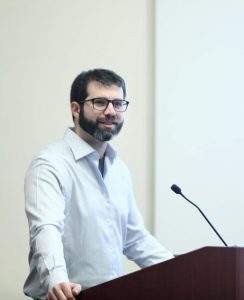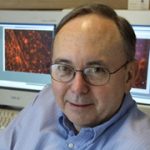Core Teaching Faculty
 Professor Martha Bosma
Professor Martha Bosma
Director Neuroscience Undergraduate Program
email: martibee@uw.edu
Neuroscience 301 Introdcution Cellular and Molecular Neuroscience
Neuroscience 302 Introduction to Systems and Behavioral Neuroscience
Research:
Our lab focuses on the early development of the brainstem region, which becomes the pons, medulla, midbrain and cerebellum. We focus on physiological and morphological aspects of serotonergic (5HT) neurons, which in the adult regulate mood, sleep and behavior. In the developing hindbrain, spontaneous waves occur that require serotonergic receptor signaling, and modulation of that signaling alters expression of the serotonergic phenotype. Using intracellular calcium imaging and patch clamp techniques, immunocytochemistry, and tissue culture techniques, we are exploring the functional development of serotonergic neurons in wildtype and transgenic animals. We find that over very short developmental periods (12-24 hours), the expression of voltage-gated ion channels and the consequent propagation of waves of spontaneous activity change dramatically. We are interested in how these changes modify the development of neuromodulatory neurons of the brainstem.
______________________________________________________________________________________________________________________________________
 Professor David Perkel
Professor David Perkel
Department of Biology
perkel@uw.edu
Neuroscience 301 Introduction to Cellular and Molecular Neuroscience
Research: I am interested in the detailed cellular mechanisms by which brains learn things. We are using vocal learning in songbirds as a model system for vocal learning in humans, and also for motor learning in general. Young songbirds learn their song first by memorizing the song of a nearby individual, usually the father. Later, they begin to vocalize and slowly match their own vocalizations to the memory of their “tutor”. The tutor does not need to be present during the practice phase, but the bird needs to have intact hearing. When the young bird achieves a good match of the tutor song, his song becomes highly stereotyped, and its maintenance becomes somewhat less dependent on hearing. Extensive information concerning the brain structures involved in song production and learning, combined with detailed subcellular understanding of synaptic plasticity phenomena such as long- term potentiation (LTP) in the mammalian hippocampus, allow us to make testable hypotheses regarding the cellular interactions that underlie this behavior. We are using in vitro brain slices obtained from zebra finches to study synaptic mechanisms and plasticity in this system. The goal of this approach is to link cellular and synaptic events with behavior, and we plan to use knowledge gained from in vitro work to guide experiments to investigate the role of synaptic plasticity in song learning in vivo.
______________________________________________________________________________________________________________________________________
Lecturer Kyobi Skutt Kakaria
Department of Psychology
kyobi@uw.edu
Neuroscience 301 Introduction to Cellular and Molecular Neuroscience
Neuroscience 302 Introduction to Systems and Behavioral Neuroscience
______________________________________________________________________________________________________________________________________
 Professor Sam Golden
Professor Sam Golden
Department of Biological Structure
email: sagolden@uw.edu
Neuroscience 401 Systems Neuroscience
Research:
Focuses on cellular, circuit, and whole brain mechanisms underlying social motivation, with an emphasis on appetitive aggression and its interaction with neuropsychiatric disorders such as addiction and depression.
______________________________________________________________________________________________________________________________________
 Professor Stanley Froehner
Professor Stanley Froehner
Chair Department of Physiology and Biophysics
email: froehner@uw.edu
Neuroscience 402 Disease of the Nervous System
Research: Synaptic transmission in the nervous system depends on highly specialized distributions of ion channels and other proteins for speed and specificity. Receptors for neurotransmitters are anchored at postsynaptic sites, where they bind the transmitter and cause a depolarization (at excitatory synapses) or a hyperpolarization (at inhibitory synapses). Strong evidence suggests that the association between receptors and intracellular membrane-associated proteins is an important feature of these specializations. Binding partners have been identified for several transmitter receptors. These include nicotinic acetylcholine receptors and rapsyn, glycine receptors and gephyrin, NMDA glutamate receptors and PSD-95, and AMPA glutamate receptors and GRIP. In many cases, the binding partner is also a scaffolding protein that links the receptor to signaling proteins, thus forming a complex of functionally interactive proteins. We study the synaptic scaffolding complex formed by dystrophin, the product of the Duchenne muscular dystrophy gene. The dystrophin complex is highly concentrated postsynaptically at the neuromuscular junction, and at some central nervous system synapses, including the outer plexiform layer of the retina. The syntrophins, which are modular adapter proteins, comprise one family of dystrophin-associated proteins. Of the five forms of syntrophin encoded by separate genes, one form is highly localized at the neuromuscular synapse and at synapses in the retina. Syntrophins bind important signaling proteins: nNOS, voltage-activated sodium channels, aquaporins, stress-activated kinase-3 (also known as p38) and a microtubule-associated serine/threonine kinase. Current research involves the search for additional syntrophin binding proteins, the investigation of the importance of syntrophin in sodium channel and nNOS localization at synapses, and the importance of syntrophins in neuronal function, especially in the retina. To study the in vivo function of syntrophins, we have produced mice lacking syntrophins. Mice lacking alpha-syntrophin have aberrant neuromuscular junctions with low amounts of nicotinic receptors and acetylcholinesterase. By combining genetic and molecular biological approaches, we hope to understand the mechanisms involved in producing the membrane specializations required for synapse formation and function.
______________________________________________________________________________________________________________________________________
 Associate Professor Greg Horwitz
Associate Professor Greg Horwitz
Department of Physiology and Biophysics
email: ghorwitz@uw.edu
Neuroscience 402 Disease of the Nervous System
Research: Vision is the result of computations occurring in the eye and brain. We seek to understand what these computations are and how they are implemented by neurons. Color vision is a particularly attractive platform for this endeavor. The front end of color processing in the visual system is understood in fine detail, as exemplified by the excellent color rendering on modern video displays. On the other hand, how color signals are processed in the cerebral cortex is still remarkably murky. This is the frontier we are pushing. Our primary experimental techniques are electrophysiological (single neuron recording and electrical microstimulation), psychophysical (measurement of detection thresholds), and computational (modeling/analysis of spike-triggered stimulus distributions). We are also exploring genetic techniques to manipulate the electrical activity of subsets of neurons in the visual system.
______________________________________________________________________________________________________________________________________
 Professor Andrea Stocco
Professor Andrea Stocco
Department of Psychology
email: stocco@uw.edu
Neuroscience 403 Computational Models of Cognitive Neuroscience
Research: I am interested in understanding the relationship between cognition and the brain from an information-processing point of view, asking questions such as “What are the fundamental computations needed for this task?” and “How can these computations be implemented within this specific brain circuit?”. In particular, I have been interested in the mechanisms that permit intelligent and adaptive behavior, with a particular focus on the interaction between prefrontal cortex and the basal ganglia.
______________________________________________________________________________________________________________________________________
 Professor Nephi Stella
Professor Nephi Stella
Department of Pharmacology
email: nstella@uw.edu
Neuroscience 404 Neuropharmacology
Research: Activation of immune cells in the CNS.
Several pathologies, such as Alzheimer’s disease and multiple sclerosis (MS), are associated with an inflammation of the CNS. The current line of research in my laboratory is to study the underlying causes and mechanisms linked to these excessive inflammatory responses in order to generate specific drugs that may temper (or even stop) those inflammations and the adjacent neuronal damages. Alzheimer’s disease primarily produces memory impairments with attention deficits while MS produces numbness with pain. Interestingly, both pathologies feature over-activated microglial cells which produce diverse toxic agents as well as directly eliminate neuronal cells by phagocytosis. Thus, microglial cells constitute a primary pharmacological target for anti-inflammatory drugs, but a further understanding of how their over-activation in Alzheimer’s patients differs from that of MS is still needed.
Traditional medicine provides a remarkable resource to study incurable pathologies, as investigating the mechanisms of action of traditional medicine’s active ingredients may reveal the origin of the pathology. MS patients commonly use cannabis-derived preparations to relieve their symptoms. Furthermore, several clinical studies and animal experiments have confirmed that drugs activating cannabinoid receptors, such as marijuana and its active component delta9-tetrahydrocannabinol, can relieve MS symptoms. Our current hypothesis is that the cannabinoid signaling pathway is impaired in MS, an assumption supported by several data:
- cannabinoid receptors are expressed by microglial cells;
- cannabinoid drugs produce immuno-suppressive responses, at least in the peripheral immune system;
- cannabinoid drugs suppress the neurological deficits observed in experimental autoimmune encephalomyelitis, an animal model of MS.
Several studies have shown that excessive stimulation of neuronal cannabinoid receptors produce loss in short-term memory and attention deficits, two cognitive impairments known to be hallmarks of Alzheimer’s disease. This similarity between cannabinoid intoxication and Alzheimer’s disease suggests a malfunction of the CNS cannabinoid signaling system in senile dementia. This hypothesis is supported by the fact that over-activated microglial cells produce endogenous cannabinoid ligands.
My lab studies the different molecular mechanisms underlying microglial cell activation, with a focus on the cannabinoid signaling pathway. To address this question, we use microglial cells in primary culture and measure the activity of the cannabinoid signaling pathway in the following manners:
- the amounts of endogenous cannabinoid ligands are measured by gas chromatography/mass spectrometry and
- the presence of cannabinoid receptors are measured by classic pharmacological approaches (binding, spectrophotometry and immunochemistry).
The long-term goal is to understand the mechanisms underlying the biology of microglial cell activation, which will potentially provide novel therapeutic avenues for the treatment of CNS immune-related pathologies.
______________________________________________________________________________________________________________________________________
 Professor Sandra Bajjalieh
Professor Sandra Bajjalieh
Department of Pharmacology
email: bajjalie@uw.edu
Neuroscience 404 Neuropharmacology
Research: Cell and Molecular Neuroscience, Excitable Membranes and Synaptic Transmission
The tightly regulated secretion of neurotransmitters is the primary form of communication in the nervous system. Transmitter secretion is mediated by a specialized membrane trafficking cycle that includes the synthesis, filling, targeting, priming, calcium-dependent fusion and recycling of transmitter-containing (synaptic) vesicles. Identifying the molecular events that produce and regulate this cycle is a first step toward understanding how genetic and environmental factors influence nervous system functioning. Towards this end, my lab is studying proteins localized to the presynaptic terminal. Our current studies focus on synaptic vesicle protein composition, the role of Synaptic Vesicle Protein 2 (SV2) in exo- and endocytosis and on lipid kinases that regulate neuronal function.